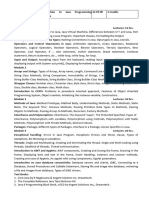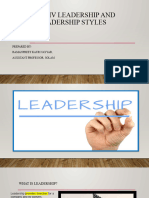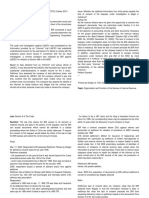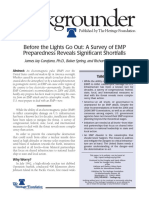Intro To Java
Uploaded by
Isha NigamIntro To Java
Uploaded by
Isha NigamCourse Structure & Syllabus of B.Tech.– Computer Science & Engg.
Applicable for Batch: 2021-25
1. Department offering the course Computer Science and Engineering
2. Course Code CSF203
3. Course Title Introduction to Java Programming
4. Credits (L:T:P:C) 3:0:1:4
5. Contact Hours (L:T:P) 3:0:2
6. Prerequisites (if any) Programming for problem solving
7. Course Basket Discipline Core
COURSE SUMMARY
This course covers Java and fundamental programming techniques with primitive data types, variables,
constants, assignments, expressions, and operators, selection statements, mathematical functions,
characters, and strings, loops, methods, and arrays. Students will learn how to write recursive methods
for solving inherently recursive problems. The next part will introduce object-oriented programming.
Java is an object-oriented programming language that uses abstraction, encapsulation, inheritance, and
polymorphism to provide great flexibility, modularity, and reusability in developing software. Students
will learn programming with objects and classes, class inheritance, polymorphism, exception handling,
abstract classes, interfaces, Text I/O and binary I/O.
COURSE OBJECTIVES
The objectives of this course are to learn object oriented programming paradigm using Java as
programming language. Students will be exposed to fundamental concepts in java programming
language, followed by object oriented paradigm and its building blocks.
COURSE OUTCOMES
On successful completion of the course, students will be able to achieve the following:
CO1: Understand and implement fundamental programming techniques and data types, variables,
constants, assignments, expressions, and operators of Java programming language.
CO2: Understand and implement selection statements, mathematical functions, characters, and strings,
loops,
CO3: Understand and implement methods, arrays and recursion using Java.
CO4: Understand and implement object-oriented paradigm using abstraction, encapsulation, inheritance,
and polymorphism.
CO5: Understand and implement the objects and classes, exception handling, abstract classes,
interfaces, Text I/O and binary I/O.
CURRICULUM CONTENT
UNIT I: Introduction, Fundamental Programming Techniques (6 L)
Introduction, the Java Language Specification, API, JDK, and IDE, Creating, Compiling, and Executing
a Java Program, Developing Java Programs Using Net Beans.
Identifiers, Variables, Assignment Statements and Assignment Expressions, Named Constants, Naming
Conventions, Numeric Data Types and Operations, Numeric Literals, Evaluating Expressions and
Operator Precedence, Increment and Decrement Operators, Numeric Type Conversions.
UNIT 2: Selection Statements, Loops, Mathematical Functions, Characters and Strings (6 L)
Boolean Data Type, if Statements, Two-Way if-else Statements, Nested if and Multi-Way if-else
Approved by the Academic Council at its 17th Meeting held on 24.03.2021
Course Structure & Syllabus of B.Tech.– Computer Science & Engg.
Applicable for Batch: 2021-25
Statements, Logical Operators, switch Statements, Conditional Expressions, Operator Precedence and
Associativity.
Common Mathematical Functions, Character Data Type and Operations, the String Type.
The while Loop, the do-while Loop, The for Loop, Nested Loops, Keywords break and continue.
UNIT 3: Methods, Arrays and Recursions (6 L)
Defining a Method, Calling a Method, Passing Arguments by Values, Modularizing Code, Overloading
Methods, The Scope of Variables, Method Abstraction and Stepwise Refinement.
Array Basics, Copying Arrays, Passing Arrays to Methods, Returning an Array from a Method,
Searching Arrays, Sorting Arrays, The Arrays Class.
Two-Dimensional Array Basics, Passing Two-Dimensional Arrays to Methods, Multidimensional
Arrays.
Recursion, writing recursive codes in Java.
UNIT4: Object Oriented Paradigm (12)
Defining Classes for Objects, Constructing Objects Using Constructors, Accessing Objects via
Reference Variables, Using Classes from the Java Library, Static Variables, Constants, and Methods,
Visibility Modifiers, Data Field Encapsulation, Passing Objects to Methods, Array of Objects,
Immutable Objects and Classes, The this Reference.
Class Abstraction and Encapsulation, Thinking in Objects, Processing Primitive Data Type Values as
Objects, Types and, The Big Integer and Big Decimal Classes, The String Class, The String Builder and
String Buffer Classes.
Superclass and Subclasses, Using the super Keyword, Overriding Methods, Overriding vs.
Overloading, The Object Class and Its to String() Method, Polymorphism, Dynamic Binding, Casting
Objects and the instance of Operator, The Object’s equals Method, The Array List Class.
UNIT5: Exception handling, Abstract Classes and Interfaces, Binary I/O. Generics (6 L)
Exception-Handling Overview, Exception Types, the finally Clause, When to Use Exceptions, Defining
Custom Exception Classes.
Abstract Classes, Interfaces, The Comparable Interface, The Clone able Interface, Interfaces vs.
Abstract Classes.
Introduction, How Is Text I/O Handled in Java?, Text I/O vs. Binary I/O, Binary I/O Classes
Motivations and Benefits, Defining Generic Classes and Interfaces, Generic Methods.
TEXTBOOK(S)
1. Intro to Java Programming (Comprehensive Version), by Y. Daniel Liang. Publisher: Pearson
Education; Tenth edition (2018), ISBN-10: 935306578X, ISBN-13: 978-9353065782
REFERENCE BOOKS
1. Java - The Complete Reference, by Herbert Schildt, Publisher: McGraw Hill Education; Tenth
edition (2017), ISBN-10: 9789387432291, ISBN-13: 978-9387432291
TEACHING AND LEARNING STRATEGY
All materials (ppts, assignments, labs, etc.) will be uploaded in Moodle. Refer to your course in Moodle
for details.
Approved by the Academic Council at its 17th Meeting held on 24.03.2021
You might also like
- Object Oriented Programming through JAVANo ratings yetObject Oriented Programming through JAVA3 pages
- Object_Oriented_Programming_through_Java_Digital_Notes_Maruthi_PNo ratings yetObject_Oriented_Programming_through_Java_Digital_Notes_Maruthi_P136 pages
- Pla1001 Programming-For-Computing-Engineers LT 1.0 7 Pla1001No ratings yetPla1001 Programming-For-Computing-Engineers LT 1.0 7 Pla10013 pages
- OOPJ_R23_II-I_MicroSylllabusFinalModelPaperNo ratings yetOOPJ_R23_II-I_MicroSylllabusFinalModelPaper8 pages
- Course-Outline of Java Programming CS 403No ratings yetCourse-Outline of Java Programming CS 4039 pages
- 24CS202_Java_Programming_Unit_3_Digital_Notes (1)No ratings yet24CS202_Java_Programming_Unit_3_Digital_Notes (1)99 pages
- Introduction To Java Programming LanguageNo ratings yetIntroduction To Java Programming Language2 pages
- Syllabus of B.Tech (CSE) 2nd Year - With CO and PO MappingNo ratings yetSyllabus of B.Tech (CSE) 2nd Year - With CO and PO Mapping27 pages
- Circular_20241130163421_Cho_23cs005_prgramming_In_JavaNo ratings yetCircular_20241130163421_Cho_23cs005_prgramming_In_Java9 pages
- 22CS202 Java Programming Unit 1 Digital NotesNo ratings yet22CS202 Java Programming Unit 1 Digital Notes90 pages
- 5th Sem Syllabus (ICT 455 Java Programming)No ratings yet5th Sem Syllabus (ICT 455 Java Programming)3 pages
- Object-Oriented Programming Through JavaNo ratings yetObject-Oriented Programming Through Java12 pages
- B.Sc. Computer Science III _ IV Semester Syllabus-minNo ratings yetB.Sc. Computer Science III _ IV Semester Syllabus-min14 pages
- Silver Oak University: College of TechnologyNo ratings yetSilver Oak University: College of Technology5 pages
- Ce4002 - Object Oriented Programming With JavaNo ratings yetCe4002 - Object Oriented Programming With Java7 pages
- Object Oriented Programming Through JavaNo ratings yetObject Oriented Programming Through Java130 pages
- CS2203 Objected Oriented Programming L-T-P-C 4-0-0-4: Externals: 60marks Internals: 40marksNo ratings yetCS2203 Objected Oriented Programming L-T-P-C 4-0-0-4: Externals: 60marks Internals: 40marks4 pages
- Academic English for Computer Science: Academic EnglishFrom EverandAcademic English for Computer Science: Academic EnglishNo ratings yet
- JavaScript OOP Step by Step: A Practical Guide with ExamplesFrom EverandJavaScript OOP Step by Step: A Practical Guide with ExamplesNo ratings yet
- Introduction To Systems Analysis and DesignNo ratings yetIntroduction To Systems Analysis and Design47 pages
- 2018-19 - Sydney Opera House Annual Report - LR SpreadsNo ratings yet2018-19 - Sydney Opera House Annual Report - LR Spreads108 pages
- Before The Lights Go Out: A Survey of EMP Preparedness Reveals Significant ShortfallsNo ratings yetBefore The Lights Go Out: A Survey of EMP Preparedness Reveals Significant Shortfalls15 pages
- ACT 203 Cost Accounting: 04/05/2023 B Com (Finance/ Accounting), RTC, ThimphuNo ratings yetACT 203 Cost Accounting: 04/05/2023 B Com (Finance/ Accounting), RTC, Thimphu35 pages
- Prepared by Nesi Zakuta: Dogus University Industial Enginering Faculty100% (1)Prepared by Nesi Zakuta: Dogus University Industial Enginering Faculty24 pages
- Dba 302 Accounting Rate of Return, NPV and Irr PresentationsNo ratings yetDba 302 Accounting Rate of Return, NPV and Irr Presentations12 pages
- Instalación Sensor Turbo Modificación 3-38-14en1No ratings yetInstalación Sensor Turbo Modificación 3-38-14en11 page
- Product Data Sheet: Easylogic Pm1120H P&E THD RS485 CL 1.0No ratings yetProduct Data Sheet: Easylogic Pm1120H P&E THD RS485 CL 1.04 pages
- Philippine Amusement and Gaming Corporation, G.R. No. 151030No ratings yetPhilippine Amusement and Gaming Corporation, G.R. No. 15103019 pages
- Traditional Network Architecture and SDNNo ratings yetTraditional Network Architecture and SDN9 pages






























































































